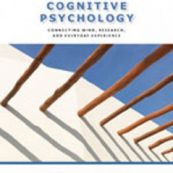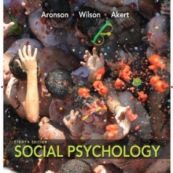Test Bank for Evolutionary Psychology: The New Science of the Mind, 4/E 4th Edition David Buss
$38.00
ISBN-10: 0205867472
ISBN-13: 9780205867479
For courses in Evolutionary Psychology.
David Buss, one of the foremost researchers in the field, has thoroughly revised his already successful text with nearly 400 new references to provide an even more comprehensive overview of this dynamic field. Using cutting-edge research and an engaging writing style, the Fourth Edition of Evolutionary Psychology ensures that your students will master the material presented.
- Description
- Reviews (0)
Description
You will receive this product immediate after placing the order
Multiple Choice Questions
1. Which of the following questions is NOT a focus of evolutionary psychology? (c)
(a) Why is the mind designed the way that it is?
(b) How do the components of the mind interact with the environment?
(c) What is the relationship between the human mind and the Big Bang?
(d) What are the functions of the components of the human mind?
2. Evolution refers to __________. (a)
(a) changes over time in organic structure
(b) differences between species
(c) changes over time in the shape of the human skull
(d) differences between men and women
3. Change in life forms over time was postulated __________. (b)
(a) first by Darwin
(b) well before Darwin’s time
(c) well after Darwin’s time
(d) first by George Williams
4. Which of the following arguments did Lamarck present? (d)
(a) Species originate from microscopic algae.
(b) Species progress toward a lower form.
(c) acquisition of inherited characteristics
(d) inheritance of acquired characteristics
5. According to Cuvier’s theory of catastrophism, species are __________. (a)
(a) extinguished by sudden catastrophes and replaced by different species
(b) irradiated by sudden catastrophes, thereafter replacing other species
(c) extinguished by gradual elimination due to disease, leaving room for new species
(d) irradiated and extinguished, and replaced by the same species
6. Which of the following clues to change in organic structure over time were not known or noted prior to Darwin? (d)
(a) cross-species structural similarities
(b) cross-species embryological similarities
(c) apparent function of traits
(d) mechanism to explain change in organic structure over time
7. Which of the following is NOT an example of genetic drift? (a)
(a) natural selection
(b) founder effect
(c) genetic bottleneck
(d) mutation
8. Which of the following is NOT one of the three essential processes identified by Darwin’s theory of evolution by natural selection? (b)
(a) variation
(b) particulation
(c) selection
(d) inheritance
9. _________ provides the “raw materials” for evolution. (a)
(a) Variation
(b) Particulation
(c) Selection
(d) Inheritance
10. For evolution to work, successful variations must be _________, or passed down reliably from parent to offspring. (d)
(a) variated
(b) particulated
(c) selected
(d) inherited
11. The process of _________ refers to the component of Darwin’s theory of evolution that states that organisms with some heritable attributes leave more offspring because those attributes help with the tasks of survival and reproduction. (c)
(a) variation
(b) particulation
(c) selection
(d) inheritance
12. In contrast to the theory of natural selection, which focused on adaptations that have arisen as a consequence of successful survival, the theory of ______________ focused on adaptations that have arisen as a consequence of successful mating. (a)
(a) sexual selection
(b) internal selection
(c) external selection
(d) social selection
13. The work of Gregor Mendel documented that __________. (c)
(a) evolution is unlikely to have occurred in pea plants
(b) evolution is unlikely to have occurred in pea genes
(c) inheritance is particulate, not blended
(d) inheritance is blended, not particulate
14. A _______ is the smallest discrete unit that is inherited by offspring intact, without being broken up or blended. (d)
(a) genotype
(b) phenotype
(c) meme
(d) gene
15. Ethologists are interested in four key issues, which became known as the four “whys” of behavior advanced by Niko Tinbergen, a founder of ethology. Which of the following is not one of the four “whys” of behavior? (a)
(a) imprinted influences of behavior
(b) immediate influences of behavior
(c) developmental influences of behavior
(d) function of behavior
16. According to Hamilton (1954), _________ is the sum of classical fitness plus the effects the individual’s actions have on the reproductive success of his or her genetic relatives, weighted by the degree of genetic relatedness. (c)
(a) direct fitness
(b) indirect fitness
(c) inclusive fitness
(d) exclusive fitness
17. Which of the following relatives is least related to you, genetically? (d)
(a) grandmother
(b) niece
(c) half-brother
(d) first cousin
18. Williams’s (1966) book clarified the concept of _________, an evolved solution to a specific problem that contributes directly or indirectly to successful reproduction. (c)
(a) genetic drift
(b) byproduct
(c) adaptation
(d) exaptation
19. Which of the following theories was not presented by Trivers in the early 1970s? (b)
(a) theory of parental investment
(b) theory of gene selection
(c) theory of reciprocal altruism
(d) theory of parent-offspring conflict
20. Edward O. Wilson’s 1975 book ignited controversy for the assertion that much of human behavior could be explained by ___________. (b)
(a) socialization
(b) evolutionary biology
(c) inclusive fitness theory
(d) ethology
21. The last chapter on humans in Edward O. Wilson’s 1975 book was __________. (b)
(a) based on research documenting the importance of cognition in human behavior
(b) based on little empirical work
(c) controversial because it portrayed humans as being subject to different evolutionary forces than other animals
(d) controversial because it did not account for the role of culture in shaping behavior
22. Which of the following is NOT a misunderstanding of evolutionary theory? (d)
(a) genetic determinism
(b) Behavior is impervious to change.
(c) Adaptations are optimally designed.
(d) Adaptations are designed to confront environmental problems.
23. Genetic determinism implies that __________. (a)
(a) genes determine behavior
(b) behavior is caused by the interaction of genes and environment
(c) culture determines all behavior
(d) if a trait is natural, it is “good”
24. Human behavior cannot occur without which of the following sets of two ingredients? (c)
(a) culture and socialization
(b) psychological machinery and natural selection
(c) adaptations and environmental input
(d) environmental input and developmental activation
25. Knowledge about evolved social psychological adaptations __________. (d)
(a) provides evidence that genes play the most important role in shaping behavior
(b) suggests that humans are different from all other animals
(c) suggests that behavior is not modifiable
(d) gives us power to change targeted behaviors
26. Which of the following does not describe evolved psychological mechanisms? (a)
(a) Evolved psychological mechanisms are optimally designed.
(b) Evolved psychological mechanisms are not optimally designed because of evolutionary time lags.
(c) Evolved psychological mechanisms are associated with costs.
(d) Adaptations work reasonably well at solving adaptive problems.
27. Which of the following is not a critical development in the evolutionary history of humans? (a)
(a) descent from mammals
(b) bipedal locomotion
(c) development of agriculture
(d) brain expansion
28. The common ancestor of all modern humans can be traced back to __________ years ago. (b)
(a) 35–40 thousand
(b) 120–150 thousand
(c) 27 million
(d) 30 million
29. William James was one of the first to posit that humans have _________ instincts than/from other animals. (c)
(a) fewer
(b) equal but different
(c) more
(d) different
30. Behaviorism was a direct reaction to __________. (d)
(a) Darwin’s theory of natural selection
(b) the cognitive revolution
(c) classical conditioning
(d) James’s psychology of instincts
31. Classical conditioning differed from operant conditioning in the role given to _________ in human behavior. (a)
(a) reinforcement
(b) radical behaviorism
(c) culture
(d) instincts
32. Behaviorists believed that ___________. (c)
(a) all behavior is instinctual, but can be modified by learning
(b) reflexes are the only instincts
(c) a general ability to learn is the only instinct
(d) there are no instincts
33. Margaret Mead was famous for __________. (b)
(a) her fieldwork studying Antarctic cultures
(b) claiming to have found cultures with reversed sex roles, and with no fighting, murder, or sexual jealousy
(c) debunking findings of cultures with reversed sex roles
(d) her writings on the thoughts, behaviors, and rituals on which learning could operate
34. Harry Harlow used the theory behind operant conditioning to predict incorrectly that __________. (a)
(a) monkeys would prefer a wire mesh mother that dispensed food
(b) monkeys would prefer a wire mesh mother with a soft cloth cover that did not dispense food
(c) monkeys would withdraw from, and be frightened by, both wire mesh mothers
(d) monkeys would prefer both wire mesh mothers equally
35. The Garcia effect refers to __________. (d)
(a) the ability to condition humans to fear things such as snakes and electrical outlets
(b) taking into account the role of learning in conditioning fears
(c) the fact that humans are wired to learn all things equally well
(d) the ability to learn some things more easily than others
36. Which of the following did not coalesce into the cognitive revolution? (c)
(a) violations of the fundamental laws of learning
(b) underlying structures for language that are invariable across cultures
(c) technology such as magnetic resonance imaging (MRI) that allowed psychologists to “peer” into the minds of humans
(d) the rise of computers
37. The cognitive revolution is synonymous with __________. (b)
(a) neurobiology
(b) information processing
(c) computers
(d) domain-general learning
38. Combinatorial explosion refers to __________. (a)
(a) the number of behaviors possible in any one situation caused by combining two or more sequential possibilities
(b) the explosion of life on the planet about 4 billion years ago
(c) the problem of not having enough domain-specific programming to account for the entire range of possible human behavior
(d) general-purpose learning mechanisms capable of an infinite range of behaviors
39. Scientists have brought three fundamental sources of evidence to bear on testing theories about origins of modern humans out of Africa. Which of the following is not one of these sources? (c)
(a) anatomical evidence
(b) archeological evidence
(c) anthropological evidence
(d) genetic evidence
40. Which of the following is the theory of human origins which has received much support from archeological evidence, though recent genetic evidence has refuted its exclusivity as a full explanation? (a)
(a) out of Africa
(b) multiregional continuity
(c) North American bottleneck
(d) creative explosion
41. All adaptations are selected for, and evolve, because they __________. (d)
(a) result in more muscular animals
(b) promote the good of the species
(c) increase the intelligence of the species
(d) promote inclusive fitness
CHAPTER 2: THE NEW SCIENCE OF EVOLUTIONARY PSYCHOLOGY
Chapter Summary
This chapter covers four topics: (1) the logic of generating hypotheses about our evolved psychological mechanisms, (2) the products of the evolutionary process, (3) the nature of evolved psychological mechanisms, and (4) the scientific procedures by which we test these hypotheses.
The logic of evolutionary hypotheses starts with an examination of the four levels of analysis, going from most general to most specific—general evolutionary theory, middle-level evolutionary theories, specific evolutionary hypotheses, and specific predictions about empirical phenomena derived from these hypotheses. One method of hypothesis generation is to start at the higher levels and move down. A middle-level theory can produce several hypotheses, each of which in turn yields several testable predictions. This can be described as the “top-down” strategy of hypothesis and prediction formation.
A second method is to start with a phenomenon known or observed to exist, such as the importance men attach to a woman’s physical appearance. From this phenomenon one can generate hypotheses about the possible function for which it was designed. This “bottom-up” method is called reverse engineering, and is a useful supplement to the top-down method, especially because we know about the existence of many human phenomena long before we have solid scientific explanations for them.
The evolutionary process produces three products—adaptations, byproducts of adaptations, and random effects or noise. Evolutionary psychologists tend to focus on adaptations. More specifically, they focus on one special subclass of adaptations that comprises human nature: psychological mechanisms.
Psychological mechanisms are information-processing devices that exist in the form they do because they solved specific problems of survival or reproduction recurrently over human evolutionary history. They are designed to take in only a narrow slice of information, transform that information through decision rules, and produce output in the form of physiological activity, information to other psychological mechanisms, or manifest behavior. The output of an evolved psychological mechanism is directed toward the solution to a specific adaptive problem. Evolved psychological mechanisms provide non-arbitrary criteria for “carving the mind at its joints,” tend to be problem-specific, and are large in number and functional in nature.
Once a hypothesis about an evolved psychological mechanism is formulated, the next step in the scientific endeavor is testing it. Testing evolutionary hypotheses relies on comparisons—finding out whether groups that are predicted to differ in a particular way actually do. This method can be used to test hypotheses by comparing different species, comparing people’s physiological reactions and brain images, comparing people with different genes, comparing males and females within a species, comparing different individuals of each sex, and comparing the same individuals in different contexts.
Evolutionary psychology has a wealth of additional sources to draw on, including the archeological record, contemporary hunter-gatherer societies, self-report, observer-report, data evoked from subjects in laboratory experiments, life-history data from public records, and products made by people.
Every source of data has strengths, but each also has limitations. Each provides information that typically cannot be obtained in the same form through other data sources. And each has flaws and weaknesses not shared by others. Studies that test evolutionary hypotheses using two or more data sources are better than studies that rely on a single data source.
The final section of this chapter outlines major classes of adaptive problems. Four classes of adaptive problems follow from modern evolutionary theory: problems of survival and growth, problems of mating, problems of parenting, and problems of genetic relatives. Additional insights into identifying adaptive problems come from knowledge of universal human structures, traditional tribal societies, paleoarcheology, task analysis, and current psychological mechanisms. Current mechanisms such as a fear of heights, a taste for fatty foods, and a preference for savanna-like landscapes provide windows for viewing the nature of past adaptive problems.
Suggested Readings
Barrett, H. C., & Kurzban, R. (2006). Modularity in cognition: Framing the debate. Psychological Review, 113, 628–647.
Buss, D. M. (Ed.) (2005). The handbook of evolutionary psychology. New York: Wiley.
Crawford, C., & Krebs, D. (Eds.) (2008). Foundations of evolutionary psychology. New York: Erlbaum.
Kennair, L. E. O. (2002). Evolutionary psychology: An emerging integrative perspective within the science and practice of psychology. Human Nature Review, 2, 17–61.
Pinker, S. (1997). How the mind works. New York: Norton.
Tooby, J., & Cosmides, L. (2005). Conceptual foundations of evolutionary psychology. In D. M. Buss (Ed.), The handbook of evolutionary psychology (pp. 5–67). New York: Wiley.
Multiple Choice Questions
1. Which of the following theories is the only known scientific theory that can explain adaptations? (b)
(a) seeding theory
(b) evolution by natural selection
(c) inclusive fitness theory
(d) creationism
2. Which of the following is not a product of evolution by natural selection? (b)
(a) adaptations
(b) sexual selection
(c) byproducts
(d) random effects
3. Adaptations must have which of the following characteristics? (c)
(a) must be present at birth
(b) must be associated with one particular gene
(c) must develop reliably
(d) must be easily identifiable
4. Five characteristics of an adaptation include __________. (a)
(a) function, efficiency, economy, precision, and reliability
(b) mutation, byproducts, economy, genetic drift, and function
(c) mutation, efficiency, reliability, function, and economy
(d) function, efficiency, economy, inclusive fitness, and optimality
5. The environment of evolutionary adaptedness refers to __________. (c)
(a) a time when humans evolved toward a common ancestor with chimpanzees
(b) a specific period of human evolution when all adaptations emerged
(c) the statistical composite of selection pressures that occurred during an adaptation’s period of evolution responsible for producing the adaptation
(d) the environment that is necessary for an adaptation to emerge
6. Adaptations initially start as __________. (b)
(a) other adaptations
(b) genetic mutations
(c) byproducts
(d) noise
7. Time periods associated with environments of evolutionary adaptedness are __________. (d)
(a) invariable
(b) specific to a time and place
(c) not unique to each adaptation
(d) unique to each adaptation
8. Byproducts __________. (a)
(a) do not solve adaptive problems and have no functional design
(b) do not solve adaptive problems but do have functional design
(c) do solve adaptive problems and have no functional design
(d) do solve adaptive problems and do have functional design
9. Which of the following is an example of a byproduct? (c)
(a) light produced by a light bulb
(b) yawning produced by being tired
(c) bellybutton produced by umbilical cord
(d) calluses produced by friction
10. What is the first level of analysis in evolutionary psychology and evolutionary biology? (c)
(a) theory of parental investment
(b) theory of reciprocal altruism
(c) inclusive fitness theory
(d) theory of parent-offspring conflict
11. General evolutionary theory would be proven false if which of the following facts were uncovered? (b)
(a) Men and women do not differ in the affection they report towards their partners.
(b) Adaptations emerged in time periods too short for natural selection to have operated.
(c) Lamarck’s theory about acquired characteristics was found to be true.
(d) Humans had group-level adaptations.
12. Which of the following theories predicts psychological differences between men and women? (c)
(a) theory of reciprocal altruism
(b) theory of parent-offspring conflict
(c) theory of parental investment
(d) inclusive fitness theory
13. The __________ an organism invests in parenting, the __________ it has to lose by making a bad mate choice. (a)
(a) more; more
(b) less; more
(c) first time; less
(d) more; less
14. In which of following species do males make greater investments in their offspring than females? (d)
(a) poison dart frog
(b) kangaroo
(c) zebra finch
(d) pipefish seahorse
15. All of the following hypotheses can be generated based on women’s preference for men with high status except __________. (d)
(a) women will value qualities known to be linked with the acquisition of resources
(b) women will gaze more at higher-status males
(c) women will be interested in sexual intercourse earlier in the relationship when the male is of higher status
(d) women will be less likely to divorce husbands who fail to provide resources
16. The first step in the top-down strategy of testing hypotheses is __________. (c)
(a) test predictions based on the hypothesis
(b) develop a hypothesis about adaptive function based on a known observation
(c) derive a hypothesis from existing theory
(d) evaluate whether empirical results confirm predictions
17. The first step in the bottom-up strategy of testing hypotheses is __________. (b)
(a) test predictions based on the hypothesis
(b) develop a hypothesis about adaptive function based on a known observation
(c) derive a hypothesis from existing theory
(d) evaluate whether empirical results confirm predictions
18. Men prefer a(n) ____________ waist-to-hip ratio than women do. (b)
(a) equal
(b) smaller
(c) larger
(d) more masculine
19. An evolved psychological mechanism that led to a successful solution in the evolutionary past ___________ lead to a successful solution now. (c)
(a) must
(b) will always
(c) may or may not
(d) cannot
20. Identifying an evolved psychological mechanism requires an identification of its ____________. (a)
(a) function
(b) physiological characteristics
(c) component parts
(d) current utility
21. Problem specificity of adaptive mechanisms tends to be favored over generality for the following reasons except __________. (c)
(a) general solutions fail to guide the organism to the correct adaptive solutions
(b) general solutions lead to too many errors and are costly to the organism
(c) general solutions are always anatomically more complex
(d) a successful solution differs from problem to problem
22. The __________ mechanisms we have, the ___________ the range of behaviors we can perform. (d)
(a) more, smaller
(b) fewer, greater
(c) fewer, larger
(d) more, greater
23. Domain-general mechanisms can be characterized by all of the following statements except __________. (c)
(a) they are difficult to identify because there are no domain-general problems
(b) the study of domain-generality has not been as fruitful an avenue of scientific pursuit as domain-specificity
(c) they do not exist
(d) several domain-specific mechanisms working together may appear to be domain-general
24. Are learning and evolved psychological mechanisms mutually exclusive explanations of human behavior, and why or why not? (d)
(a) Yes, because evolved psychological mechanisms are reflexes and do not require input from the environment, unlike learning.
(b) Yes, because learning overrides our evolved psychological mechanisms.
(c) No, because evolved psychological mechanisms are learned during development.
(d) No, because learning requires the presence of evolved psychological mechanisms to occur.
25. Which of the following cues was shown to have the most influence on incest avoidance behaviors? (b)
(a) degree of genetic relatedness
(b) duration of co-residence with a member of the opposite sex during childhood
(c) parents passing on knowledge of which individuals are unsuitable for mating
(d) amount of time spent playing together during adolescence
26. Psychological mechanisms are theorized to have access only to the information stored within them, and cannot access information contained in other psychological mechanisms except via information-sharing mechanisms. This phenomenon is referred to as __________. (d)
(a) compartmentalization
(b) repression
(c) subconscious
(d) encapsulation
27. Male chimpanzees have relatively _________ testes than human males because of the greater selection pressure of female promiscuity in chimpanzees. (a)
(a) larger
(b) smaller
(c) equal
(d) fewer
28. Sperm competition is generally present in all of the following species except __________. (a)
(a) exclusively monogamous species
(b) moderately monogamous species
(c) polygamous species
(d) promiscuous species
Be the first to review “Test Bank for Evolutionary Psychology: The New Science of the Mind, 4/E 4th Edition David Buss”
You must be logged in to post a review.














Reviews
There are no reviews yet.